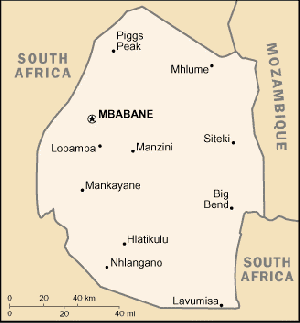Difference between revisions of "Swaziland"
| [unchecked revision] | [checked revision] |
GameoAdmin (talk | contribs) (CSV import - 20130820) |
GameoAdmin (talk | contribs) (CSV import - 20130823) |
||
| Line 1: | Line 1: | ||
| − | [[File:Swaziland_map.gif|300px|thumb|right|''Swaziland, 2006. World factbook map | + | [[File:Swaziland_map.gif|300px|thumb|right|''Swaziland, 2006. World factbook map'']] [[File:Swaziland1.jpg|300px|thumb|right|''Source: [http://en.wikipedia.org/wiki/Image:LocationSwaziland.svg Wikipedia Commons]'']] [[File:Swaziland2.jpg|300px|thumb|right|''Source: [http://en.wikipedia.org/wiki/Image:LocationSwaziland.svg Wikipedia Commons]'']] Swaziland is a kingdom in southern Africa (17,364 sq. km.; 6,704 sq.mi.; population in 1982, 600,000; in 2005, 1,173,900). The first [[Mennonite Central Committee (International)|Mennonite Central Committee ]] and [[Eastern Mennonite Missions (Lancaster Mennonite Conference)|Eastern Mennonite Board of Missions and Charities]] ([[Mennonite Church (MC)|Mennonite Church]]) personnel arrived in Swaziland in 1971 to begin a program which is registered as "The Mennonite Board of Swaziland." The program began with three teachers in the Teachers Abroad Program. By 1976, there were 26 people working in vocational training, health, agriculture, handicapped concerns, Bible education, and church leadership training (mainly with the [[African Independent Churches|African Independent Churches]]). In 1985 the program consisted of 17 people. There has always been a significant emphasis on working in cooperation with local churches and other established institutions. Due to Swaziland's geographic location, South African and Mozambican refugees have frequently been a major focus of the Swaziland Mennonite program. |
| − | |||
| − | '']] [[File:Swaziland1.jpg|300px|thumb|right|''Source: [http://en.wikipedia.org/wiki/Image:LocationSwaziland.svg Wikipedia Commons] | ||
| − | |||
| − | '']] [[File:Swaziland2.jpg|300px|thumb|right|''Source: [http://en.wikipedia.org/wiki/Image:LocationSwaziland.svg Wikipedia Commons] | ||
| − | |||
| − | '']] Swaziland is a kingdom in southern Africa (17,364 sq. km.; 6,704 sq.mi.; population in 1982, 600,000; in 2005, 1,173,900). The first [[Mennonite Central Committee (International)|Mennonite Central Committee]] and [[Eastern Mennonite Missions (Lancaster Mennonite Conference)|Eastern Mennonite Board of Missions and Charities]] ([[Mennonite Church (MC)|Mennonite Church]]) personnel arrived in Swaziland in 1971 to begin a program which is registered as "The Mennonite Board of Swaziland." The program began with three teachers in the Teachers Abroad Program. By 1976, there were 26 people working in vocational training, health, agriculture, handicapped concerns, Bible education, and church leadership training (mainly with the [[African Independent Churches|African Independent Churches]]). In 1985 the program consisted of 17 people. There has always been a significant emphasis on working in cooperation with local churches and other established institutions. Due to Swaziland's geographic location, South African and Mozambican refugees have frequently been a major focus of the Swaziland Mennonite program. | ||
{{GAMEO_footer|hp=Vol. 5, p. 868|date=1989|a1_last=Nussbaum|a1_first=Gloria|a2_last= |a2_first= }} | {{GAMEO_footer|hp=Vol. 5, p. 868|date=1989|a1_last=Nussbaum|a1_first=Gloria|a2_last= |a2_first= }} | ||
Latest revision as of 14:21, 23 August 2013


Swaziland is a kingdom in southern Africa (17,364 sq. km.; 6,704 sq.mi.; population in 1982, 600,000; in 2005, 1,173,900). The first Mennonite Central Committee and Eastern Mennonite Board of Missions and Charities (Mennonite Church) personnel arrived in Swaziland in 1971 to begin a program which is registered as "The Mennonite Board of Swaziland." The program began with three teachers in the Teachers Abroad Program. By 1976, there were 26 people working in vocational training, health, agriculture, handicapped concerns, Bible education, and church leadership training (mainly with the African Independent Churches). In 1985 the program consisted of 17 people. There has always been a significant emphasis on working in cooperation with local churches and other established institutions. Due to Swaziland's geographic location, South African and Mozambican refugees have frequently been a major focus of the Swaziland Mennonite program.
| Author(s) | Gloria Nussbaum |
|---|---|
| Date Published | 1989 |
Cite This Article
MLA style
Nussbaum, Gloria. "Swaziland." Global Anabaptist Mennonite Encyclopedia Online. 1989. Web. 21 Nov 2024. https://gameo.org/index.php?title=Swaziland&oldid=93667.
APA style
Nussbaum, Gloria. (1989). Swaziland. Global Anabaptist Mennonite Encyclopedia Online. Retrieved 21 November 2024, from https://gameo.org/index.php?title=Swaziland&oldid=93667.
Adapted by permission of Herald Press, Harrisonburg, Virginia, from Mennonite Encyclopedia, Vol. 5, p. 868. All rights reserved.
©1996-2024 by the Global Anabaptist Mennonite Encyclopedia Online. All rights reserved.

